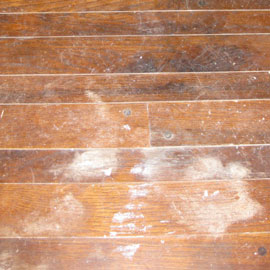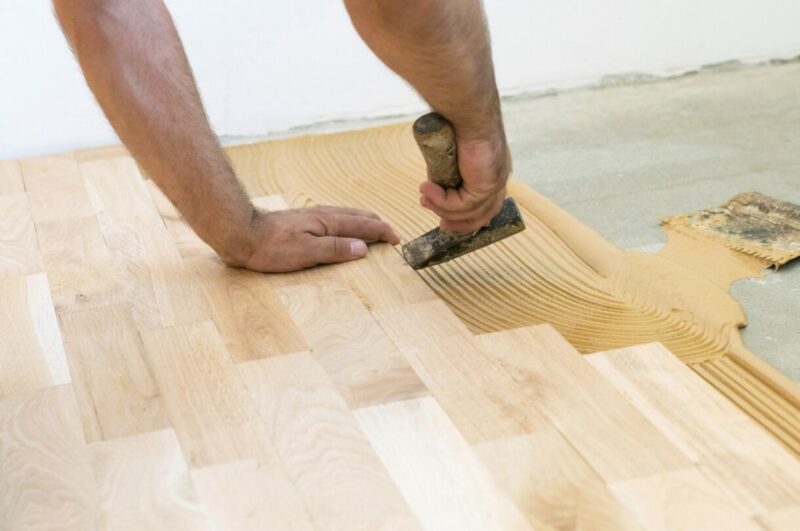To fix faded wood floors, you can sand and refinish them to restore their original color and shine. Sanding will remove the old finish and expose fresh wood, while refinishing will protect the floor and enhance its appearance.
Wood floors can add a timeless charm and warmth to any space. Over time, however, these beautiful floors can become faded and lackluster due to exposure to sunlight, foot traffic, and general wear and tear. Fortunately, there is a simple solution to revive and restore your faded wood floors.
One of the most effective ways to fix faded wood floors is by sanding and refinishing them. Sanding removes the old finish, scratches, and imperfections, revealing the fresh wood underneath. This process also levels the floor, creating a smooth surface for the new finish. Once the sanding is complete, the next step is to apply a new finish to protect the wood and bring back its natural beauty. Choosing the right finish is crucial, as it determines the final look and durability of your wood floors. Sanding and refinishing is a cost-effective and efficient way to fix faded wood floors, rejuvenating them to their former glory. By following these steps, you can enjoy the beauty and elegance of your wood floors for years to come.
1. Understanding Faded Wood Floors: Common Causes And Signs
Understanding Faded Wood Floors: Common Causes and Signsstrong>
Faded wood floors can be an eyesore and diminish the overall aesthetic appeal of your home. Identifying the signs of faded wood floors is crucial to addressing the issue promptly. Look out for dull and lackluster surfaces, areas with minimal color variation, and spots that have lost their luster.
Possible causes of faded wood floors include excessive exposure to sunlight, improper cleaning methods, and the use of harsh chemicals. Sunlight can cause fading over time, while certain cleaning products can strip away the protective coatings and damage the wood’s finish.
Addressing faded wood floors is important not only for preserving the beauty of your home but also for maintaining the value of your investment. Refinishing the floors can revive their color and shine, providing a fresh and vibrant look to your space. Regularly cleaning and maintaining the floors can also help prevent further fading.
2. Preparing For Wood Floor Restoration: Tools And Materials
Restoring faded wood floors requires essential tools and materials to ensure a successful restoration process. Here are a few key considerations:
| Tools | Materials |
|---|---|
| – Sanding machine | – Wood floor cleaner |
| – Edger | – Wood stain or floor paint |
| – Orbital sander | – Polyurethane sealer |
| – Vacuum cleaner | – Wood filler |
| – Buffer | – Tack cloth |
| – Scraper | – Paintbrushes or rollers |
Choosing the right materials is crucial for achieving the desired outcome in wood floor restoration. Wood floor cleaner helps to remove dirt and grime, while wood stain or floor paint adds color and protects the wood. Polyurethane sealer provides a durable finish, and wood filler is used to fill in any cracks or gaps. It’s important to use tack cloth to remove debris before applying finishes.
During the restoration process, it’s important to prioritize safety. Take the following safety precautions:
- Wear protective eye goggles, gloves, and a dust mask.
- Ensure proper ventilation in the work area to minimize exposure to fumes.
- Follow the manufacturer’s instructions for using tools and chemicals.
- Keep children and pets away from the workspace.
- Remove any flammable materials from the area.
3. Step-by-step Guide To Fixing Faded Wood Floors
Faded wood floors can be a common issue, but with the right steps, you can bring them back to their former glory. The process involves cleaning and preparing the wood surface, sanding and refinishing the wood floor, and finally applying a protective coat and finishes.
To begin, start by cleaning the wood surface thoroughly. Remove any debris or dust using a soft-bristle broom or vacuum cleaner. Next, use a mild wood cleaner and a damp cloth to gently wipe down the floor, ensuring that it is free from dirt and grime.
Once the surface is clean, it’s time to sand the wood floor. Start by using a coarse sandpaper to remove the existing finish, scratches, and imperfections. Gradually switch to finer-grit sandpaper until the floor feels smooth to the touch.
After sanding, it’s essential to apply a protective coat and finishes to restore the wood floor’s beauty and protect it from future damage. Choose an appropriate wood finish, such as polyurethane or varnish, and apply it using a brush or roller, following the manufacturer’s instructions.
By following these step-by-step instructions, you can effectively fix faded wood floors and transform them into stunning features of your home.
4. Expert Tips To Revive Your Faded Wood Floors
Expert Tips to Revive Your Faded Wood Floors
Choosing the right stain for a natural look:
| Tip | Description |
|---|---|
| 1 | Consider the wood species – different types of wood may require different stains. |
| 2 | Test the stain – apply a small amount in an inconspicuous area to determine the desired color. |
| 3 | Apply multiple coats – layering the stain can enhance the depth of color. |
Restoring wood floors with furniture marks and scratches:
If your wood floors have furniture marks or scratches, there are a few techniques you can try to restore their appearance. For light surface scratches, use a wood floor cleaner and a soft cloth to gently buff out the blemishes. For deeper scratches, you may need to apply a wood filler or putty to level the surface. Once dry, lightly sand the area and refinish with the appropriate stain or sealant. Remember to always follow the manufacturer’s instructions and test on a small, inconspicuous area before proceeding.
Maintaining the beauty of your wood floors involves regular cleaning and maintenance practices. Here are some tips to help prevent future fading and keep your floors looking their best:
- Keep floors clean and free from debris – sweep or vacuum regularly to prevent scratches from dirt and grit.
- Protect floors from direct sunlight – use curtains or blinds to minimize exposure to UV rays.
- Use rugs or mats in high-traffic areas – this helps reduce wear and tear on the wood surface.
- Regularly check for moisture – excess moisture can cause warping or damage to wood floors, so be vigilant and address any leaks promptly.
5. Diy Vs. Hiring Professionals: Which Is The Right Choice?
Faded wood floors can be a real eyesore, but don’t worry – they can be fixed! When it comes to restoring your wood floors, you have the option of DIY or hiring professionals. There are pros and cons to both approaches, so it’s important to consider the benefits and challenges of each.
DIY restoration can be a cost-effective solution for fixing faded wood floors. By taking matters into your own hands, you can save money on labor costs. However, it’s crucial to evaluate the extent of the damage and your level of expertise. Minor issues, such as surface scratches or light fading, can often be handled with a DIY approach using products like wood floor restorers or refinishing kits.
However, for more severe damage or if you lack the necessary skills and tools, hiring professionals may be the right choice. They have the expertise and experience to tackle complex issues like deep stains, water damage, or extensive fading. They also have access to specialized tools and high-quality materials that can deliver superior results.
In conclusion, the decision between DIY and hiring professionals for faded wood floor restoration depends on several factors. Consider the extent of the damage, your skills and resources, and the cost-effectiveness of each option. By weighing these considerations, you can choose the right approach to bring back the beauty of your wood floors.
6. Reviving Faded Wood Floors: Inspiring Before And After Transformations
Reviving Faded Wood Floors: Inspiring Before and After Transformationsstrong>
Restoring faded wood floors can bring new life and charm to your home. Seeing the before and after results is truly captivating, as these real-life examples demonstrate.
1. Photos showcasing the impact of wood floor restoration
Inspiration strikes when you witness the remarkable transformations that wood floor restoration can achieve. Photos of dull and worn floors taken earlier can be starkly contrasted with images of vibrant and rejuvenated wood floors after restoration.
2. Stories of homeowners’ experiences with revitalized wood floors
Homeowners who have undertaken wood floor restoration eagerly share their experiences. These stories tell tales of faded floors being revived to their former glory. They highlight how refinishing and resealing processes can remove scratches and stains, revealing the innate beauty hidden beneath.
By exploring these examples and stories, you’ll discover a wealth of inspiration and validation for reviving the faded wood floors in your own home.

Frequently Asked Questions On How To Fix Faded Wood Floors
How Do You Fix Sun-faded Hardwood Floors Without Sanding?
To fix sun-faded hardwood floors without sanding, try using a wood stain or finish. Apply the product with a cloth or brush in the direction of the grain. Allow it to dry, then repeat if necessary. This process can help restore the color and rejuvenate your floors without the need for sanding.
How Do You Treat Faded Wood Floors?
To treat faded wood floors, start by sanding the surface to remove the existing finish. Next, apply a wood stain in the desired shade, making sure to follow the manufacturer’s instructions. Finally, seal the floor with a clear polyurethane finish to protect and enhance its appearance.
How Do You Revive Dull Wood Floors?
To revive dull wood floors, follow these steps: 1. Clean the floors thoroughly with a mild cleaner and warm water. 2. Sand the floors lightly to remove scratches and imperfections. 3. Apply a wood floor polish or wax for shine and protection.
4. Buff the floors with a soft cloth or a floor buffer for a brilliant finish. 5. Regularly clean and maintain the floors to keep them looking vibrant.
How Do You Revive A Wood Floor Without Refinishing It?
Reviving a wood floor without refinishing it is possible. Start by cleaning the floor thoroughly. Then, apply a wood floor cleaner and buff the surface using a microfiber pad or a soft cloth. Lastly, apply a coat of wood floor restorer to bring back its shine and protect it from future damage.
Conclusion
Reviving faded wood floors can be a daunting task, but with the right techniques, it is possible to restore their former glory. By following the steps outlined in this guide, you can bring back the natural beauty of your wood floors.
From sanding and refinishing to applying a fresh coat of paint or stain, these methods will give your floors a new lease on life. So don’t let faded wood floors deter you anymore – take action and enjoy your beautifully restored floors for years to come.




